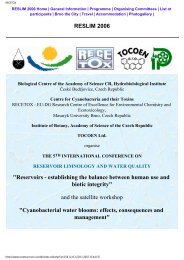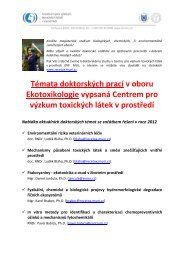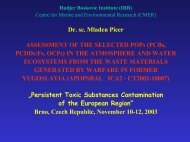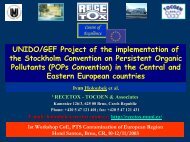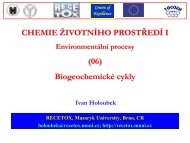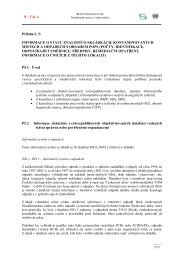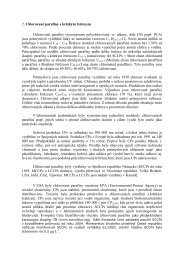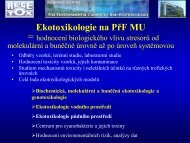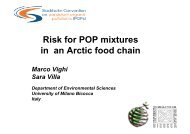Monitoring of persistent organic pollutants in soils of the Czech ...
Monitoring of persistent organic pollutants in soils of the Czech ...
Monitoring of persistent organic pollutants in soils of the Czech ...
Create successful ePaper yourself
Turn your PDF publications into a flip-book with our unique Google optimized e-Paper software.
1)<br />
MONITORING OF PERSISTENT ORGANIC POLLUTANTS IN SOILS OF THE<br />
CZECH REPUBLIC<br />
Milan Sáňka 1) , Jiří Zbíral 2) , Karel Provazník 2) , Šárka Poláková 2)<br />
Centre for Environment and Land Assessment EKOTOXA s.r.o. Kosmákova 28, 615 00 Brno,<br />
tel.: +420 549 241 411, e-mail: milan.sanka@iol.cz,<br />
2)<br />
The Central Institute for Supervis<strong>in</strong>g and Test<strong>in</strong>g <strong>in</strong> Agriculture, Hroznová 2, 656 06 Brno, e-mail:<br />
jiri.zbiral@ukzuz.cz, karel.provaznik@ukzuz.cz<br />
Introduction<br />
Soil survey, monitor<strong>in</strong>g and <strong>in</strong>ventarization programs are <strong>in</strong>evitable tools to def<strong>in</strong>e soil properties for a<br />
given area (country), <strong>in</strong>clud<strong>in</strong>g <strong>the</strong> status <strong>of</strong> pollution. Most European countries have developed <strong>the</strong>ir<br />
own monitor<strong>in</strong>g system focused on <strong>the</strong> ma<strong>in</strong> soil characteristics. Agricultural purposes were<br />
emphasised but environmental <strong>in</strong>terests are becom<strong>in</strong>g to play more and more important role <strong>in</strong> <strong>the</strong>se<br />
systems. That is why also potentially toxic substances, <strong>in</strong>clud<strong>in</strong>g <strong>persistent</strong> <strong>organic</strong> <strong>pollutants</strong> (POPs)<br />
are be<strong>in</strong>g <strong>in</strong>troduced <strong>in</strong>to monitor<strong>in</strong>g systems.<br />
In <strong>the</strong> <strong>Czech</strong> Republic <strong>the</strong> systematic monitor<strong>in</strong>g <strong>of</strong> POPs is carried out on two levels:<br />
1. As a part <strong>of</strong> basal soil monitor<strong>in</strong>g scheme (BSMS) on permanent plots on agricultural soil and<br />
<strong>in</strong> protected areas (conducts Central Institute for Supervis<strong>in</strong>g and Test<strong>in</strong>g <strong>in</strong> Agriculture),<br />
2. <strong>Monitor<strong>in</strong>g</strong> for specific purposes <strong>in</strong> order to f<strong>in</strong>d <strong>the</strong> sources and levels <strong>of</strong> POPs <strong>in</strong> different<br />
areas and to propose some remediation measures (conducts Research Institute for Land<br />
Reclamation and Soil Conservation).<br />
The system and results <strong>of</strong> BSMS is <strong>the</strong> object <strong>of</strong> this contribution. The BSMS became a part <strong>of</strong> <strong>the</strong><br />
<strong>Czech</strong> legislation by accept<strong>in</strong>g <strong>the</strong> Act on fertilisers No. 156/98 S.B. (<strong>in</strong> word<strong>in</strong>g <strong>of</strong> later regulations)<br />
and connected decrees as a tool support<strong>in</strong>g decision-mak<strong>in</strong>g process <strong>in</strong> state adm<strong>in</strong>istration.<br />
Evaluation and cont<strong>in</strong>uous assessment <strong>of</strong> both levels <strong>of</strong> monitor<strong>in</strong>g is carried out and submitted to <strong>the</strong><br />
M<strong>in</strong>istry <strong>of</strong> Agriculture and <strong>the</strong> M<strong>in</strong>istry <strong>of</strong> Environment.<br />
Figure 1. Location <strong>of</strong> permanent POPs monitor<strong>in</strong>g plots <strong>in</strong> <strong>the</strong> <strong>Czech</strong> Republic.
Materials and method<br />
The program <strong>of</strong> monitor<strong>in</strong>g is be<strong>in</strong>g realized <strong>in</strong> different types <strong>of</strong> land use on agricultural soil (arable<br />
land, grassland, special crops) s<strong>in</strong>ce 1992. The irregular network consists <strong>of</strong> 189 representative<br />
monitor<strong>in</strong>g plots <strong>in</strong> standard conditions, 27 monitor<strong>in</strong>g plots <strong>in</strong> highly polluted areas and <strong>of</strong> 40<br />
monitor<strong>in</strong>g plots on undisturbed soil <strong>in</strong> protected areas. The contents <strong>of</strong> selected POPs (table 1) are<br />
monitored on 35 plots on agricultural land (chosen from 189 standard condition plots and from 27<br />
contam<strong>in</strong>ated plots) and on 5 plots <strong>in</strong> <strong>the</strong> protected areas (figure 1). The sampl<strong>in</strong>g period is one-year.<br />
Each monitor<strong>in</strong>g plot both <strong>in</strong> <strong>the</strong> agricultural and protected areas subsystem is a rectangle cover<strong>in</strong>g an<br />
area <strong>of</strong> 1000m 2 (25 x 40m). Individual samples are taken from each sampled layer accord<strong>in</strong>g to <strong>the</strong><br />
scheme <strong>in</strong> figure. 2. The <strong>in</strong>dividual subsamples are bulked to provide approximately one kilogram <strong>of</strong> a<br />
composite soil sample from each sampled layer. There are two sampled layers on agricultural <strong>soils</strong>:<br />
plough layer and subplough layer with <strong>the</strong> thickness <strong>of</strong> <strong>the</strong> plough layer accord<strong>in</strong>g to <strong>the</strong> particular<br />
conditions on <strong>the</strong> plot. The maximum depth <strong>of</strong> a subplough layer is up to 60 cm. Ten centimetres <strong>of</strong><br />
soil between <strong>the</strong> two sampled layers is excluded. With<strong>in</strong> <strong>the</strong> protected areas subsystems <strong>the</strong> soil is<br />
sampled accord<strong>in</strong>g to A and B soil genetic horizons.<br />
Figure 2: Scheme for soil sampl<strong>in</strong>g on <strong>the</strong> monitor<strong>in</strong>g plot.<br />
In <strong>the</strong> period <strong>of</strong> 1994 – 1997 only <strong>the</strong> plots with wheat on agricultural <strong>soils</strong> were sampled (i.e. <strong>the</strong> set<br />
<strong>of</strong> plots was different each year). S<strong>in</strong>ce 2000 <strong>the</strong> plots given <strong>in</strong> figure 1 are sampled each year,<br />
regardless <strong>the</strong> crop. More details are <strong>in</strong> table 1.<br />
Table 1. List <strong>of</strong> <strong>in</strong>dividual POPs analysed <strong>in</strong> BSMS samples each year<br />
substance<br />
period<br />
Atraz<strong>in</strong> and its metabolites<br />
deethylatraz<strong>in</strong><br />
till 1996 <strong>in</strong>cl.<br />
deisopropylatraz<strong>in</strong><br />
till 1996 <strong>in</strong>cl.<br />
Persistent organochlor<strong>in</strong>ated pesticides and <strong>the</strong>ir metabolites<br />
αHCH, βHCH, γHCH 1994-97, s<strong>in</strong>ce 2000<br />
HCB 1994-97, s<strong>in</strong>ce 2000<br />
o,p'-DDE, p,p'-DDE, o,p'-DDD, p,p'-DDD, o,p'-DDT, p,p'-DDT 1994-97, s<strong>in</strong>ce 2000<br />
Polychlor<strong>in</strong>ated biphenyls (PCB)<br />
congeners 138, 153, 180 s<strong>in</strong>ce 1994<br />
congeners 138, 153, 180, 28, 52, 101 s<strong>in</strong>ce 1998<br />
congeners 138, 153, 180, 28, 52, 101, 118 s<strong>in</strong>ce 2000<br />
Polycyclic aromatic hydrocarbons (PAH)<br />
16 <strong>in</strong>dividual hydrocarbons accord<strong>in</strong>g to <strong>the</strong> EPA list s<strong>in</strong>ce 1997<br />
Results and conclusions<br />
The basic statistical characteristics for <strong>the</strong> contents <strong>of</strong> all observed POPs dur<strong>in</strong>g <strong>the</strong> whole period <strong>of</strong><br />
monitor<strong>in</strong>g are given <strong>in</strong> table 2. Only data for arable soil (both plough layer and subsoil) were<br />
processed statistically s<strong>in</strong>ce <strong>the</strong>re has not been enough data for o<strong>the</strong>r types <strong>of</strong> land use <strong>in</strong> <strong>in</strong>dividual<br />
years yet.
Table 2. Basic statistical characteristics for contents <strong>of</strong> POPs on arable soil. (µg.kg -1 )<br />
Sum <strong>of</strong> PAH 1) Sum <strong>of</strong> PCB 2) HCB DDT 3) DDE 3) DDD 3)<br />
year descriptive<br />
statistics P S P S P S P S P S P S<br />
ar. mean - - 1,1 1,6 5,6 3,1 19,2 12,4 10,9 7,9 2,5 1,6<br />
1995<br />
median - - 0,8 0,8 5,7 2,6 15,4 10,1 12,0 6,3 1,2 0,8<br />
ar. mean - - 1,9 1,1 5,2 2,4 26,8 15,5 11,4 7,6 2,6 1,3<br />
1996<br />
median - - 0,8 0,8 6,1 1,9 21,4 8,8 10,7 6,2 2,1 1,0<br />
ar. mean 986 433 7,9 3,5 8,2 6,4 114,6 54,4 72,2 22,3 9,6 6,8<br />
1997<br />
median 667 323 0,8 0,8 7,2 4,4 37,4 17,0 19,8 14,6
monitor<strong>in</strong>g period, however, <strong>the</strong>re is a considerable variation among <strong>the</strong> <strong>in</strong>dividual years on several<br />
plots. It can be due to some spot contam<strong>in</strong>ation from agricultural appliances.<br />
The results for organochlor<strong>in</strong>ated pesticides are shown <strong>in</strong> figure 3. The contents <strong>of</strong> HCH were below<br />
<strong>the</strong> detection limit <strong>of</strong> <strong>the</strong> analytical procedure <strong>in</strong> all cases. There is a change <strong>in</strong> trends <strong>of</strong> <strong>the</strong> <strong>in</strong>dividual<br />
pesticides <strong>in</strong> two periods: period 1994-1997 <strong>in</strong> which <strong>the</strong> location <strong>of</strong> plots was changed each year and<br />
period 2000-2002 <strong>in</strong> which <strong>the</strong> same plots were sampled. There is no very clear trend <strong>in</strong> <strong>the</strong> first<br />
period, but <strong>in</strong> <strong>the</strong> second one we can see <strong>in</strong>creas<strong>in</strong>g <strong>of</strong> HCB and DDE and decreas<strong>in</strong>g <strong>of</strong> DDT<br />
(possibly chang<strong>in</strong>g <strong>of</strong> DDT to metabolite DDE). This can be seen both <strong>in</strong> plough layer and subsoil,<br />
although without statistical significance. No such trends were found for DDD metabolite.<br />
Contents <strong>of</strong> all substances were statistically significantly lower <strong>in</strong> subsoil than <strong>in</strong> plough layer.<br />
The limit values were exceeded mostly for DDT (36% <strong>of</strong> samples <strong>in</strong> 2002).<br />
Figure 3. Medians <strong>of</strong> <strong>the</strong> organochlor<strong>in</strong>ated pesticides contents on permanent BSMS monitor<strong>in</strong>g plots<br />
<strong>in</strong> <strong>the</strong> period 1994 – 2002.<br />
µg/kg<br />
50<br />
40<br />
HCB, DDE, DDD, DDT<br />
1994 1995 1996 1997 2000 2001 2002<br />
66.8<br />
30<br />
20<br />
10<br />
0<br />
topsoil subsoil topsoil subsoil topsoil subsoil topsoil subsoil<br />
HCB DDE DDD DDT<br />
References<br />
SÁŇKA, M. – CHVÁTAL, V. - NĚMEC, P. (1998) : Bazální monitor<strong>in</strong>g zemědělských půd a<br />
monitor<strong>in</strong>g atmosférické depozice – metodické postupy. ÚKZÚZ Brno, 1998.<br />
SÁŇKA, M. (2001): Contents, sources and possible assessment methods <strong>of</strong> heavy metals and <strong>organic</strong><br />
<strong>pollutants</strong> <strong>in</strong> agricultural <strong>soils</strong> <strong>of</strong> <strong>the</strong> <strong>Czech</strong> Republic. Proceed<strong>in</strong>gs form <strong>the</strong> conference “Soil<br />
science: past, present and future”, Prague, <strong>Czech</strong> Republic, September 16 – 20, 2001.<br />
PROVAZNÍK, K. – POLÁKOVÁ, Š. – FLORIÁN, M. – MALÝ, S. – CHVÁTAL, V. – KULA, E. –<br />
DANIELOVÁ, L. (2003): kontrola a monitor<strong>in</strong>g cizorodých látek v zemědělské půdě a vstupech do<br />
půdy. Zpráva za rok 2002, ÚKZÚZ Brno.



